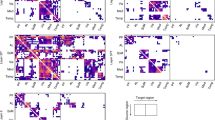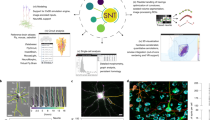Abstract
A central aim of neuroscience is to map neural circuits, in order to learn how they account for mental activities and behaviours and how alterations in them lead to neurological and psychiatric disorders. However, the methods that are currently available for visualizing circuits have severe limitations that make it extremely difficult to extract precise wiring diagrams from histological images. Here we review recent advances in this area, along with some of the opportunities that these advances present and the obstacles that remain.
This is a preview of subscription content, access via your institution
Access options
Subscribe to this journal
Receive 12 print issues and online access
$189.00 per year
only $15.75 per issue
Buy this article
- Purchase on Springer Link
- Instant access to full article PDF
Prices may be subject to local taxes which are calculated during checkout



Similar content being viewed by others
References
Sotelo, C. Viewing the brain through the master hand of Ramon y Cajal. Nature Rev. Neurosci. 4, 71–77 (2003).
Callaway, E. M. & Sanes, J. R. New technologies. Curr. Opin. Neurobiol. 16, 540–542 (2006).
Nauta, W. J. Some early travails of tracing axonal pathways in the brain. J. Neurosci. 13, 1337–1345 (1993).
Callahan, C. A., Yoshikawa, S. & Thomas, J. B. Tracing axons. Curr. Opin. Neurobiol. 8, 582–586 (1998).
Feinstein, P., Bozza, T., Rodriguez, I., Vassalli, A. & Mombaerts, P. Axon guidance of mouse olfactory sensory neurons by odorant receptors and the β2 adrenergic receptor. Cell 117, 833–846 (2004).
Bareyre, F. M., Kerschensteiner, M., Misgeld, T. & Sanes, J. R. Transgenic labeling of the corticospinal tract for monitoring axonal responses to spinal cord injury. Nature Med. 11, 1355–1360 (2005).
Dymecki, S. M. & Kim, J. C. Molecular neuroanatomy's “Three Gs”: a primer. Neuron 54, 17–34 (2007).
Song, C. K., Enquist, L. W. & Bartness, T. J. New developments in tracing neural circuits with herpesviruses. Virus Res. 111, 235–249 (2005).
Luo, L., Callaway, E. M. & Svoboda, K. Genetic dissection of neural circuits. Neuron 57, 634–660 (2008).
Horowitz, L. F., Montmayeur, J. P., Echelard, Y. & Buck, L. B. A genetic approach to trace neural circuits. Proc. Natl Acad. Sci. USA 96, 3194–3199 (1999).
Yoshihara, Y. et al. A genetic approach to visualization of multisynaptic neural pathways using plant lectin transgene. Neuron 22, 33–41 (1999).
Wickersham, I. R. et al. Monosynaptic restriction of transsynaptic tracing from single, genetically targeted neurons. Neuron 53, 639–647 (2007).
Macagno, E. R., Levinthal, C. & Sobel, I. Three-dimensional computer reconstruction of neurons and neuronal assemblies. Annu. Rev. Biophys. Bioeng. 8, 323–351 (1979).
White, J. G., Southgate, E., Thomson, J. N. & Brenner, S. The structure of the nervous system of the nematode Caenorhabditis elegans. Philos. Trans. R. Soc. Lond. B Biol. Sci. 314, 1–340 (1986).
Denk, W. & Horstmann, H. Serial block-face scanning electron microscopy to reconstruct three-dimensional tissue nanostructure. PLoS Biol. 2, e329 (2004).
Briggman, K. L. & Denk, W. Towards neural circuit reconstruction with volume electron microscopy techniques. Curr. Opin. Neurobiol. 16, 562–570 (2006).
Hayworth, K., Kasthuri, N., Schalek, R. & Lichtman, J. W. Automating the collection of ultrathin serial sections for large volume TEM reconstructions. Microsc. Microanal. 12, 2 (2006).
Gan, W. B., Grutzendler, J., Wong, W. T., Wong, R. O. & Lichtman, J. W. Multicolor “DiOlistic” labeling of the nervous system using lipophilic dye combinations. Neuron 27, 219–225 (2000).
Tsien, R. Y. The green fluorescent protein. Annu. Rev. Biochem. 67, 509–544 (1998).
Shaner, N. C., Steinbach, P. A. & Tsien, R. Y. A guide to choosing fluorescent proteins. Nature Methods 2, 905–909 (2005).
Feng, G. et al. Imaging neuronal subsets in transgenic mice expressing multiple spectral variants of GFP. Neuron 28, 41–51 (2000).
Walsh, M. K. & Lichtman, J. W. In vivo time-lapse imaging of synaptic takeover associated with naturally occurring synapse elimination. Neuron 37, 67–73 (2003).
Kasthuri, N. & Lichtman, J. W. The role of neuronal identity in synaptic competition. Nature 424, 426–430 (2003).
Lichtman, J. W. & Sanes, J. R. Watching the neuromuscular junction. J. Neurocytol. 32, 767–775 (2003).
Zong, H., Espinosa, J. S., Su, H. H., Muzumdar, M. D. & Luo, L. Mosaic analysis with double markers in mice. Cell 121, 479–492 (2005).
Livet, J. et al. Transgenic strategies for combinatorial expression of fluorescent proteins in the nervous system. Nature 450, 56–62 (2007).
Gan, W. B., Kwon, E., Feng, G., Sanes, J. R. & Lichtman, J. W. Synaptic dynamism measured over minutes to months: age-dependent decline in an autonomic ganglion. Nature Neurosci. 6, 956–960 (2003).
Grutzendler, J., Kasthuri, N. & Gan, W. B. Long-term dendritic spine stability in the adult cortex. Nature 420, 812–816 (2002).
Nguyen, Q. T., Sanes, J. R. & Lichtman, J. W. Pre-existing pathways promote precise projection patterns. Nature Neurosci. 5, 861–867 (2002).
Trachtenberg, J. T. et al. Long-term in vivo imaging of experience-dependent synaptic plasticity in adult cortex. Nature 420, 788–794 (2002).
Micheva, K. D. & Smith, S. J. Array tomography: a new tool for imaging the molecular architecture and ultrastructure of neural circuits. Neuron 55, 25–36 (2007).
Peters, M. F. et al. Differential membrane localization and intermolecular associations of α-dystrobrevin isoforms in skeletal muscle. J. Cell Biol. 142, 1269–1278 (1998).
Fritze, C. E. & Anderson, T. R. Epitope tagging: general method for tracking recombinant proteins. Methods Enzymol. 327, 3–16 (2000).
Bates, M., Huang, B., Dempsey, G. T. & Zhuang, X. Multicolor super-resolution imaging with photo-switchable fluorescent probes. Science 317, 1749–1753 (2007).
Heintzmann, R. & Ficz, G. Breaking the resolution limit in light microscopy. Methods Cell Biol. 81, 561–580 (2007).
Hell, S. W. Far-field optical nanoscopy. Science 316, 1153–1158 (2007).
Huang, B., Wang, W., Bates, M. & Zhuang, X. Three-dimensional super-resolution imaging by stochastic optical reconstruction microscopy. Science 319, 810–813 (2008).
Shroff, H. et al. Dual-color superresolution imaging of genetically expressed probes within individual adhesion complexes. Proc. Natl Acad. Sci. USA 104, 20308–20313 (2007).
Ramón y Cajal, S. Estudios Sobre la Degeneración y Regneración del Sistema Nervioso (Moya, Madrid, 1913–1914); reprinted and edited with additional translations by DeFelipe, J. & Jones, E. G. Cajal's Degeneration and Regeneration of the Nervous System (Oxford Univ. Press, New York, 1991).
Hubel, D. H., Wiesel, T. N. & LeVay, S. Plasticity of ocular dominance columns in monkey striate cortex. Philos. Trans. R. Soc. Lond. B Biol. Sci. 278, 377–409 (1977).
Author information
Authors and Affiliations
Corresponding author
Rights and permissions
About this article
Cite this article
Lichtman, J., Livet, J. & Sanes, J. A technicolour approach to the connectome. Nat Rev Neurosci 9, 417–422 (2008). https://doi.org/10.1038/nrn2391
Published:
Issue Date:
DOI: https://doi.org/10.1038/nrn2391
This article is cited by
-
Laminin-coated electronic scaffolds with vascular topography for tracking and promoting the migration of brain cells after injury
Nature Biomedical Engineering (2023)
-
Analysis of brain signal processing and real-time EEG signal enhancement
Multimedia Tools and Applications (2022)
-
Good neighbors, bad neighbors: the frequent network neighborhood mapping of the hippocampus enlightens several structural factors of the human intelligence on a 414-subject cohort
Scientific Reports (2020)
-
Changes of brain structural network connection in Parkinson’s disease patients with mild cognitive dysfunction: a study based on diffusion tensor imaging
Journal of Neurology (2020)
-
Diverse Community Structures in the Neuronal-Level Connectome of the Drosophila Brain
Neuroinformatics (2020)



